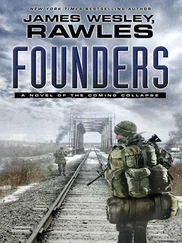The shortest of the three men tossed a pillowcase to Janelle and ordered, “Fill it! Dump the cash tray and the cash under the tray in, too.” She quickly opened the cash register and complied. As she handed the sack back to the man, one of the others, with an acne-scarred complexion, hissed, “You pick up the phone in less than five minutes and I’ll come back here next week and empty this gun into you.”
The three men fled just as Janelle heard the sound of the vertically mounted Skilsaw winding down. She ran toward her husband in a panicked dash. “We’ve just been robbed,” she shouted over the noise. Jake hesitated only for a moment before unholstering his SIG pistol. He started walking toward the front of the store, cautiously. Behind him, Janelle said, “Three young black guys, all wearing hoodies. Two of them have guns.” Jake glanced at the open cash register and the register’s empty cash tray sitting at an odd angle.
They heard tires screeching outside the store. Jake picked up his pace and jogged to the hardware store’s front entrance. As he ran out the door, he caught just a glimpse of an older Ford Taurus racing down the street. He stopped and lowered his pistol. Then he noticed that his hands were shaking.
“Call 911! Black Ford Taurus sedan. Tell ’em they’re headed south on State Road 19!” he shouted to Janelle. Then muttering to himself, he added, “And they’ll be lost in the traffic and down in Orlando before the cops even get out of the donut shop.”
Their store had been burglarized the year before, so they’d added bars to the windows and beefed up the back door. But they hadn’t expected an armed robbery during the day. To Janelle, robberies had seemed like something that happened only to jewelry shops, liquor stores, and gas stations—and then mainly in Jacksonville or Orlando.
The robbery made the Altmillers seriously reconsider security for their small hardware store. The store had been established by Jake’s grandfather, who had bought the 2.5-acre lot for just twelve hundred dollars during World War II. Situated south of the Dora Canal, it had been in continuous operation since 1946. It was also the last family-owned, independent hardware store in Lake County. All of the others had long since been affiliated with chains like Ace or True Value, or run out of business by the big-box giants like Home Depot and Lowe’s. And while they’d suffered their share of shoplifting, this was the first time they’d ever been robbed at gunpoint.
A few days after the robbery, the Altmillers added four miniature security cameras that recorded directly to their PC’s hard drive. One of these cameras was deliberately set up at a low angle to avoid the classic “view of the top of the perp’s baseball cap.” Another camera was aimed at the front entrance, and contrasting strips of colored tape were added at one-foot intervals running up both sides of the door frame. When seen in surveillance footage, these markings would allow them to approximate the height of a suspect after a robbery.
Most importantly, Janelle and Jake began to carry their pistols daily. They both took the three-day fighting pistol immersion course taught by Florida Firearms Training in Okeechobee. This was Janelle’s first formal firearms instruction. For Jake, who had taken two previous classes by other instructors, the comprehensive course made him realize how much he still had to learn. They both made a point of doing monthly practice shooting sessions at the local range on Sunday afternoons when the store was closed.
Janelle stood just five feet two inches tall—eight inches shorter than her husband. Her rounded hips and short trunk made most hip holsters uncomfortable for her. Drawing her pistol from a hip holster was ungainly because of the short distance between the top of the holster and her armpit. She tried several types of right-handed holsters before settling on a modified Kydex cross-draw holster made by Multi Holsters. She concealed it with the blue Altmiller’s Hardware logo canvas vests that they wore to identify store employees. By wearing the vest unbuttoned, she could draw the pistol quickly if needed. On the few occasions when a customer caught a glimpse of the holstered pistol, it usually triggered compliments rather than ridicule. Florida, after all, had one million concealed carry pistol permits—the most of any state. There was a reason it was nicknamed the Gunshine State.
“Ever since the religion of Islam appeared in the world, the espousers of it… have been as wolves and tigers to all other nations, rending and tearing all that fell into their merciless paws, and grinding them with their iron teeth; that numberless cities are raised from the foundation, and only their name remaining; that many countries, which were once as the garden of God, are now a desolate wilderness; and that so many once numerous and powerful nations are vanished from the earth! Such was, and is at this day, the rage, the fury, the revenge, of these destroyers of human kind.”
—John Wesley (1703–1791)
Semarang, Indonesia—May, Two Years Before the Crunch
Adhi Wulandari was an ambitious perantara insinyur , an intermediate engineer, with a midsize electronics company in Jakarta. He had just survived a big layoff. This had been the first time the company had let go more than just assemblers. Two friends from his department—one from New Zealand and one from Singapore—were the company’s only foreign-born employees. Without warning, they had been told to pack up the personal contents of their cubicles and were escorted out the door. It soon became apparent that all of the others singled out in the layoff were non-Muslims, leaving the company with a one hundred percent Muslim staff. The circumstances of the layoff troubled Wulandari.
The next day, word came of a lucrative new video camera assembly contract. Why would the company need to lay off anyone when they’ve just received a new contract? Wulandari wondered. Everyone else seemed happy to still have their jobs, so they didn’t ask many questions.
While reviewing the drawing specifications for the new assembly contract, Wulandari noticed that the drawings were incomplete. The diagrams showed only one half of a clamshell housing marked CAMERA CASE, a battery, and a digital timer. The large round center section of the housing was a blank spot in the drawings, marked simply as CAMERA POSITION (TBD). The empty space also seemed unusually large for a digital camera, given their recent miniaturization. Even stranger, there were no molded projections in the plastic to hold a camera in place.
All of the parts for the assembly project came in from several other subcontractors: 252 unmarked gray plastic cases from an injection molding company in Tasikmalaya, boxes of aluminum screws from a fastener supply company in Banjarsari, 252 five-year-life 48-volt lithium manganese dioxide batteries sourced from China, bundles of green LEDs from a parts vendor in Jakarta Tangerang, and 252 generic programmable digital timers made by Omron.
The battery specification also struck Wulandari as unusual. Rechargeable lithium-ion batteries would have been a better choice for a camera system. Why would they specify a 48-volt disposable battery, and why did they need one with such a high voltage and amp-hour rating? He surmised that they wanted to emplace “set and forget” espionage cameras for several years, but the specifications still seemed incongruous.
When the 252 timers arrived, he grew even more suspicious. They were packed in cardboard boxes labeled OMRON AUTOMATION—a major electronics company in Jakarta Selatan—but the timers themselves were completely unmarked. Every other electronics subassembly he’d ever worked with had carried at least a maker’s name and part number. The lack of any markings further piqued his curiosity.
Читать дальше












